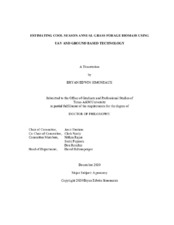| dc.description.abstract | Many research institutions conduct annual forage trials to determine which species and varieties of those species produce the most biomass in specific geographical areas. These trials can be costly, time consuming and labor intensive to conduct. A cool-season annual grass forage trial was conducted at the Texas A&M Research Farm during the 2015-2016 and 2016-2017 growing seasons. This forage trial tests small grains species such as wheat, oat, rye, triticale, and barley in addition to annual ryegrass. The purpose of this research was to determine if Unmanned Aerial Vehicle (UAV) technology or other ground-based sampling methods could replace traditional forage harvesting techniques. The ultimate goal of this project was to develop a low cost and effective method to measure above ground forage biomass.
If researchers are unable to take destructive samples, both visual and plant height measurements were highly correlated for fall and late spring clips. Combining all measurements of the traditional methods into one model to predict forage yield may be a better way to estimate forage yield if the whole plot forage harvest is not possible. In the UAV and ground-based methods no one variable showed a strong relationship across all clip times or species. Models were developed for each species and clip time to better predict forage yield using multiple variables. In some cases, the models did improve the coefficient of determination (R2) substantially, but in many cases, improvement was marginal. The ground model did as good as or better than the aerial model for wheat, oat, barley and the combined model, whereas the aerial model was far better for rye. There was little to no difference between the ground and aerial models for ryegrass. Transforming the data also had little effect on model accuracy for wheat, oat and barley. However, transforming the data for rye had a negative effect while ryegrass and the combined species model were improved when the data was transformed.
The best results for evaluating multi species across clip times was the traditional method model created from visual rating, plant height and subsample weight. It seemed far better when evaluating a multi species trial to do so at specific times during the growing season as opposed to throughout the growing season. If only a single species is being evaluated, it seemed that species a specific method and clip time was ideal. | en |


